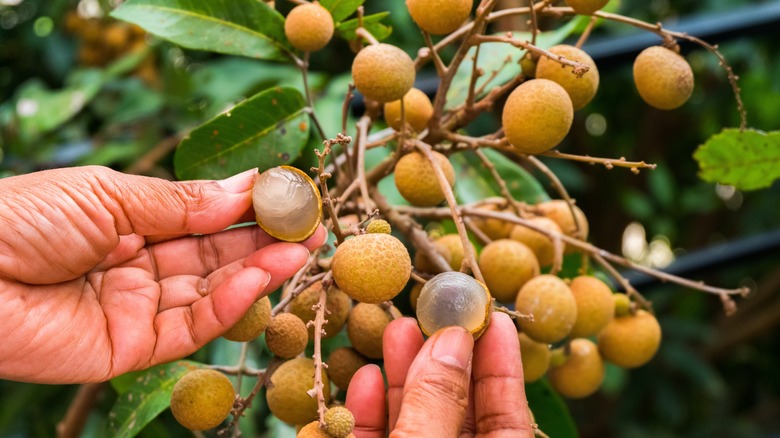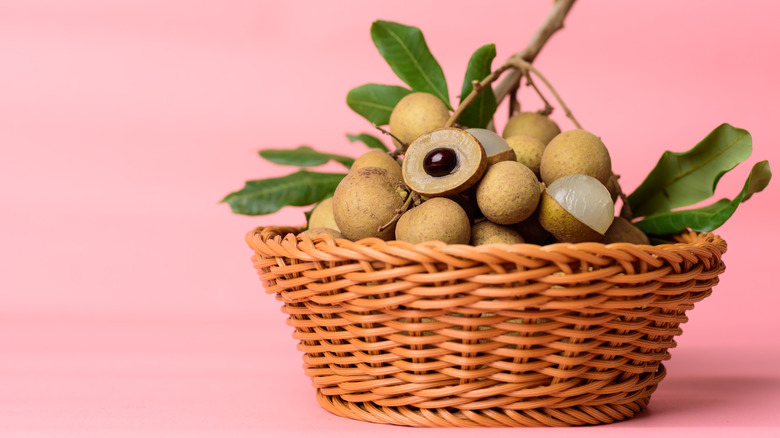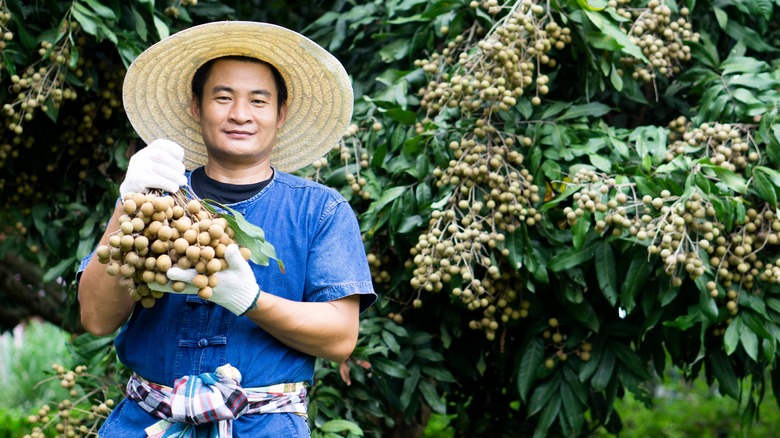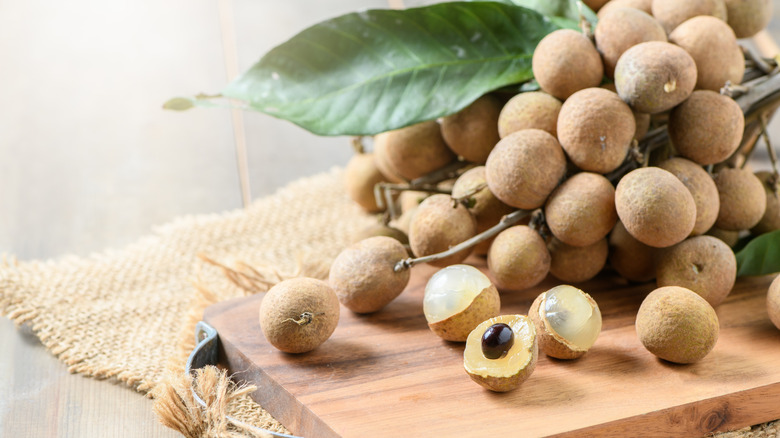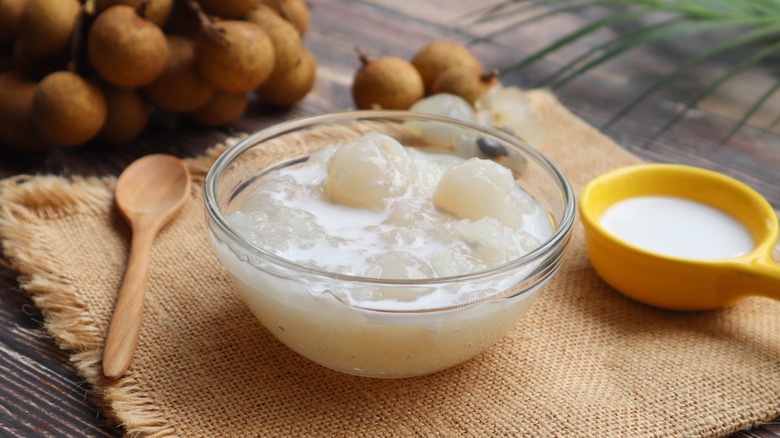What You Need To Know About The Tropical Longan Fruit
Walk into your standard grocery store, and you'll be met with a wide variety of colorful fruits. Grocery stores have left us spoiled for choice, but even with the impressive selection available, we're sometimes left wanting more.
After all, there's a whole world full of fruits and vegetables out there. Based on your climate, you may need to put in a little effort if you want something more exotic.
If you're craving something out of the norm, try hunting down the longan fruit. With a similar look and flavor as lychees, longans are popular in Asia but relatively rare in the rest of the world (via Web MD). If they're not common in your area, they may be tricky to hunt down — but the nutritious and flavorful fruits are worth the work. The Kitchn recommends checking your local Asian market, but you might be able to order them through specialty fruit stores, too.
What are longans?
Originating in Southeast Asia, the longan fruit (Dimocarpus longan) can easily be mistaken for its popular cousin, the lychee (via Growables). They're in the same family, along with rambutan and akee. Longans are roughly the size of a large grape, with sweet white flesh surrounded by tough, tan, leathery skin. They grow in clusters on large evergreen trees and have a sweet, musky flavor.
According to South China Morning Post, the word "longan" originates from Cantonese and translates to "dragon's eyes." Cut a longan in two, and you'll see why: the dark seed surrounded by white pulp resembles an eye. Longans are widely grown in southern China and northern regions of Vietnam and Thailand.
While longans are an important crop in Southeast Asia — one Thai town even hosts a yearly longan festival — they're often outshined by lychees. Purdue University notes that many people prefer the sweeter, more succulent taste of lychee fruit. It's ultimately a matter of personal taste, though, and Healthline explains that both longan and lychee have similar nutritional value.
However, longans do have advantages over lychee. As Purdue University explains, longan trees are hardier than lychees. The fruits are also more durable: in contrast to perishable lychees, longan fruits stay good for several days, thanks to their thick, firm rinds.
How is longan fruit grown?
According to The University of Florida, the longan is a subtropical fruit, typically harvested in late August through September. The trees can grow over 100 feet tall, with large, shiny leaves and small flowers.
Longans grow relatively easily in tropical climates. The trees are tolerant to drought and grow well in sandy or rocky soil. Plus, pests tend to avoid them. An article originally published in Agricultural Research Magazine notes that longans — like lychees — are impervious to the flies that plague other tropical fruits, like guava.
According to Purdue University, the United States Department of Agriculture introduced longan trees to Florida in the early 1900s. The fruit flourished in the Florida climate but didn't catch on commercially. In the 1950s, William Whitman introduced the Hawaiian Kohala variety to the mainland United States. Kohala longans are large and flavorful, distinctly better than the longans previously grown in the US. Now, The University of Florida claims that 99% of longans grown in Florida are Kohala.
Health benefits of longan fruit
As Purdue University explains, longan fruit isn't as popular as lychees in its native China — at least, not to eat. Instead, it's valued as traditional medicine. According to Food Plants of China, longan is a common ingredient in "bupin," a sort of slow-cooked stew made of plants believed to have medicinal properties. The book notes that bupin are typically meant more as a health supplement than as a cure for any particular ailment. Healthline adds that, in traditional medicine, longan is used to increase energy, reduce stress, and boost memory — but emphasizes that these claims are anecdotal.
However, while not all of the longan's health benefits have been verified by science, the fruit is extremely nutritious. According to Web MD, just one serving of longan will provide you with nearly a day's dose of vitamin C. Thanks to its high concentration of vitamin C, longan can help improve your tissue health and promote collagen creation. The fruit is also high in potassium. Many nutritionists believe that modern Americans don't get as much potassium as they should, leading to elevated blood pressure and increased risk of stroke.
How to cook with longan fruit
While longan fruit is often seen as medicine, it's still widely eaten throughout China and Southeast Asia. Fresh longans are popular, but Brittanica notes that the fruit is commonly sold dried or canned in syrup, too.
Congee flavored with longan pulp is a common Cantonese delicacy; Unfamiliar China explains that longan and goji berries give the dish a sweet taste. According to South China Morning Post, the fruit is particularly popular in Northern Thailand, where it's eaten in curries, stir-fries, and ice cream. In the Thai town of Lamphun, which hosts an annual longan festival, local shops sell noodles in pork broth with longan.
Longan fruit is also used as the base for longan wine. According to The Oxford Companion to Wine, China only started growing the vinifera grapes used in European wines recently. However, longan was traditionally cultivated for wine production in Western China and along the Great Wall.
Modern cooks have come up with their own interpretations: FruitStand explains that longans can be used in everything from cheesecake to cocktails. Web MD adds that, since fresh, dried, and canned longans have such distinct flavor profiles, they can be used in a variety of different ways. Fresh longan goes well in fruit salads, and dried longan can be added to teas. If you're up for an experiment, try incorporating it into a dish of your own.
